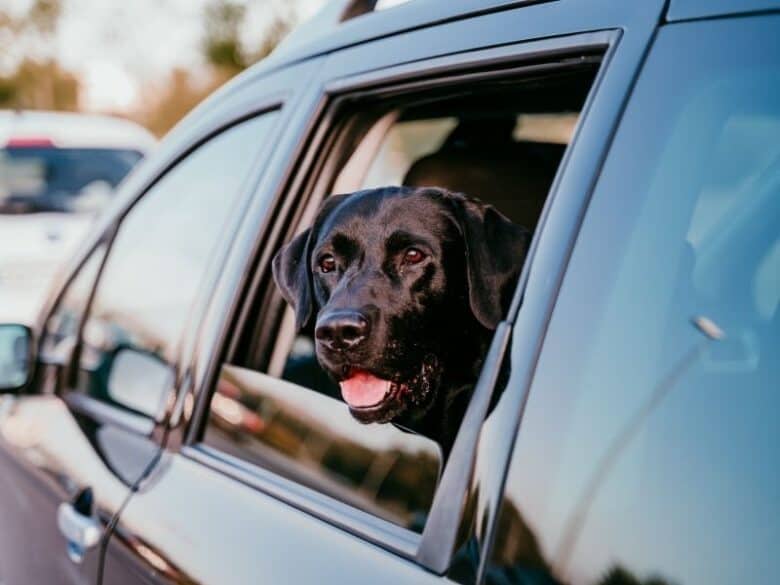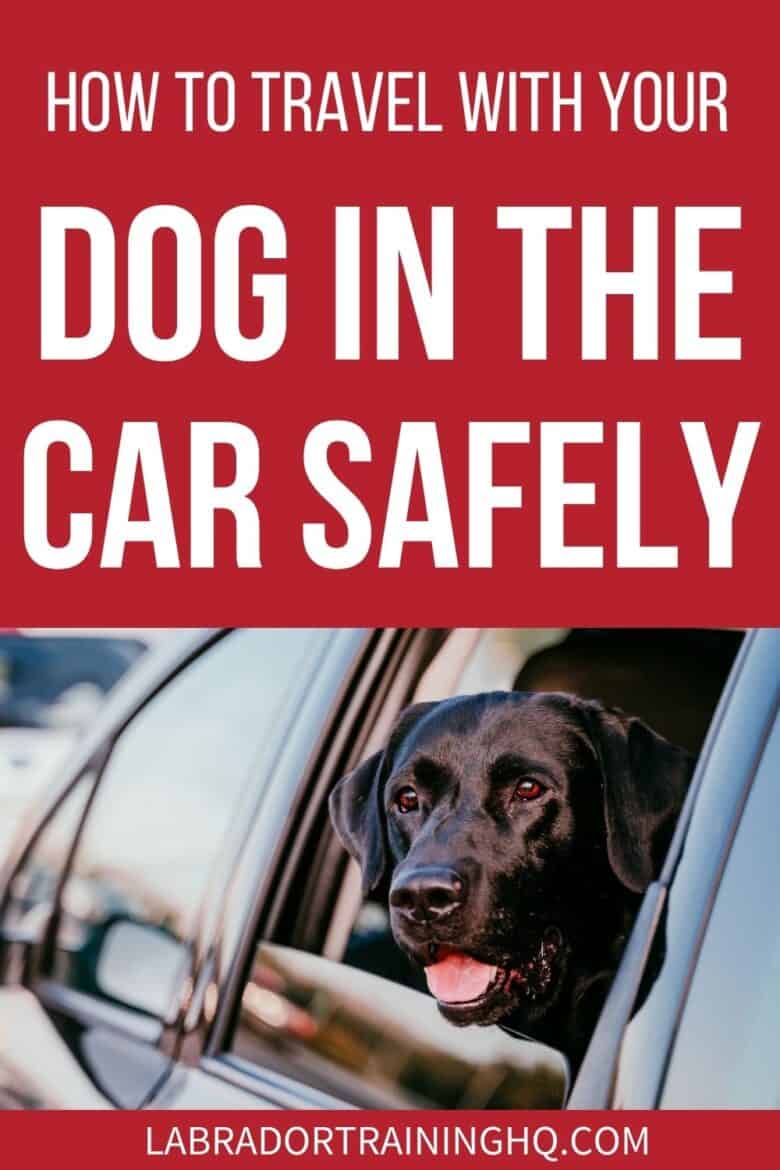This post may contain affiliate links. We may earn money or products from the companies mentioned in this post.
Your dog’s a beloved family member. So, of course, you want to take him along on your vacation. Or even on short trips in your neighborhood.
After all, who doesn’t love a road trip?
But you want to make sure that everyone–including your dog Max–is safe on your journey.
It takes some planning to be sure that you have everything necessary for your trip. And that includes the safest way to transport Max.

In this article, I’ll discuss what some of the best ways are to transport your beloved canine as well as other matters to consider for your trip.
Contents & Quick Navigation
What To Bring on Your Trip
Even for short trips, it’s important to be prepared. Your dog will need certain things to have a safe, happy, healthy trip.
Pet Travel Kit
You should bring items for your pup that you may need. These can include food/water bowls, his food, bottled water, treats, toys, and chews that he’s accustomed to.
You may also need grooming supplies, poop bags, his bed, and medications your dog needs.
Make sure your pup’s vaccinations are up-to-date. You should also pack evidence of his vaccinations, including his rabies tag, which he may be required to wear by state or local laws.
Include any health certifications that may be required where you’re going.
It’s also good to be prepared with the phone number and address of any emergency veterinarians at and along the road to your destination.
Your dog should also wear some type of identification should he become lost. Also consider having him microchipped. Discuss this with your vet.
If you do have him microchipped, please be sure to register him in your name because most vets who implant the chip don’t do so.
Also pack a canine first aid kit in case you need it.
Safety First
Your pup is used to cuddling with you on the sofa. So it’s natural that he wants to ride on your lap while you’re driving.
Of course, it’s very unsafe for many reasons to let him do so.
Even if he rides in the seat next to you, the airbag may be triggered should an accident occur. This is life-threatening for your beloved companion.
Also, your sweet canine could become a dangerous projectile if you have to stop short or are in an accident.
Or a dog sitting in the front can inadvertently block or move the gear shift, steering wheel, or gas or brake pedals.
Although a dog with his head stuck out of the window, with his tongue out and hair blowing in the breeze, may appear to be cute, it’s really dangerous.
The pup may get an eye injury if something blows into his eye. Or he may injure his neck or the rest of his body if he’s tossed around by the car’s motion.
And no dog should be left in a hot car. Even with the windows down, a car can quickly reach high temperatures that threaten your dog’s life.
And if the window’s opened too wide, he may even jump out when he sees something alluring like a squirrel.
It’s important too to lock the doors and windows–including child-proof locks–so that a canine Houdini doesn’t escape.
Also check out your local and state dog laws and distracted driving laws regarding whether and how your dog should be restrained while traveling in your vehicle.
Never leave your dog unattended in a vehicle even with the air or heat on. A dog may be stolen when left alone.
And, last but not least, never let a dog travel in the bed of a pick-up truck. He could easily be thrown around and injured when the truck’s in motion even if restrained.
The exposure to heat and cold can also be harmful to your beloved canine. And many dogs will be injured trying to escape.
Recommended Methods of Restraint While Traveling
There are many different methods for your dog to safely travel in your vehicle for your adventures.
I’ll discuss a few of the most popular ones that have been proven to keep your pup safe if used properly.
Of course, you should get your dog used to any method of traveling before you actually go on your trip.
Dog Harness Seat Belt
Our regular seat belts aren’t meant for dogs. But there are great dog harnesses with tethers that are made to attach to a vehicle’s seat belts.
Once the dog is safely strapped into his harness and the tether is snapped into the car’s seat belt, the dog’s prevented from wandering or flying around in the car.
But this type of device is generally not suited for puppies because they may chew on the harness or tether and get free.
It’s best suited for a well-behaved dog who doesn’t try to escape from it.
As is true with any type of restraint, it’s best for your dog to receive a sufficient amount of exercise prior to the ride so that he’s calmer during the trip.
The tether of a seat belt harness should never be attached to a collar. Or the dog could suffer severe neck and back injuries.
Travel Crate
A travel crate can be a great way for your dog to ride safely in your vehicle.
But, like any other type of restraint, it’s best for him to be used to being in a crate outside of the vehicle.
If your dog hasn’t been trained to be in a crate, you shouldn’t just put him in one in the car and expect him to accept it.
Rarely, such a dog may accept the crate. But most of the time, a dog may panic and try to escape or otherwise be extremely stressed in it.
He may whine, bark, dig, and even use his teeth and get injured attempting to escape from the crate.
So, get him used to a crate in the house before you use it in the car. It will probably take time–even weeks–to get him to accept being in a crate.
And, if he has any behavioral issues such as separation anxiety, you have to deal with the issue before using a crate.
There are different types of crates. There are wire collapsible ones and soft-sided collapsible crates. There are also plastic kennels.
The type you use should be large enough for your dog to stand up in, turn around in, and lie down in comfortably.
Of course, space is a consideration. If you have a golden or Labrador retriever, he requires a very large crate or kennel.
So, if you have a sedan, a large crate or kennel may not be an option. Whereas if you have a small-to-medium-sized dog, you may be able to fit the crate or kennel on your back seat folded down.
If you have a minivan, hatchback, or SUV, you have more options regarding using a crate or kennel.
Some dogs feel more comfortable in a wire crate because they can see out better, whereas others like the security of a plastic kennel. Each dog’s an individual.
Of course, it may not be appropriate for a puppy to ride in a cloth crate because he may chew on it.
When I get a new puppy or dog, I introduce them over time to a wire crate, plastic kennel, and cloth collapsible crates.
I take my dogs many places and need them to be used to all types. Cloth crates are great because they are light to carry, so I can easily take the crate into a building.
However, I think that cloth crates are generally too flimsy for riding in a vehicle. I prefer plastic kennels or sturdy wire crates for traveling.
Whatever you choose, make sure that it’s secured down (such as with bungee cords) so that it doesn’t fly around the vehicle.
They even make impact-safe travel crates. These are crash-tested for safety and are designed for a cargo area.
They won’t fit in the back seat of a car. And they are more expensive than most other crates.
Barrier-type Methods
If you can’t use a seat-belt harness or crate or kennel, there are other options.
There are pet hammocks, which essentially block your dog between the front and rear seats. He lies on the hammock.
This works in cars as well as other vehicles.
There are also cargo area pet barriers for SUVs, hatchbacks, and minivans.
The problems with the hammocks and pet barriers are that the dog can still be thrown around if a vehicle stops short or is in an accident.
But at least the dog is usually safer than being tossed around or climbing around the entire vehicle.
Bu tsome pet hammocks have openings to also use a pet harness so that your dog rides safely while your seats are also protected.
Sometimes these are the only options depending on the size of your dog and your vehicle.
Additional Considerations for Traveling
Bringing our canine family members along on our trips necessitates other preparations.
Before taking any long journeys, get your dog used to traveling. Take short trips first.
If your dog gets motion sickness, get him used to associating the vehicle with positive things. He can be in the car, with the air or heat on as appropriate, and you just sit there.
You can give him an item he likes to chew. After a few minutes (or as long as he remains calm), you can take him out of the vehicle.
Over time, take him on short rides. If he gets motion sickness, you can talk to your vet about giving him something to help.
Take him to positive places, not just to the vet.
Before your trip, don’t feed your dog for at least three hours prior to leaving.
Don’t give your dog treats while on the road because he may choke.
Always make sure that the car is well-ventilated. Have the air conditioning or heat on as is appropriate for the weather conditions.
If you’re going on a long trip and need to stop at hotels or motels along the way and at your destination, make sure that they’re pet friendly for your type of dog.
Some take only dogs up to a certain size/weight. And some don’t take certain breeds.
And don’t forget that your dog will need to stop for regular potty breaks and may need to drink some water periodically.
Other Options
There are other options that are available. But some are available only for smaller dogs. And others are dangerous.
Car or Booster Seat
There are specially-made car seats that are for smaller dogs. Dogs like shih tzus and Yorkies can fit into these.
They attach to the headrest and most secure the dog into a harness attached to the car seat.
The car seat should be placed only in a rear seat without an air bag, not in the front passenger seat because there’s air bag.
Some small dogs like traveling in one because they can see out of the window.
Zipline Harness Seat Belt Tether
These are a line across the rear seats in a car. The dog is attached in a harness. The harness attaches to the line.
These are not recommended because dogs can still unsafely be jolted around in the car.
Also, they don’t meet the safety standards of the Center for Pet Safety.
Final Thoughts
Traveling with your dog can be a great adventure. But it’s important to determine how he should travel safely and get him used to that method.
It’s also essential to prepare certain necessities for an uneventful, safe, fun trip.
Have you traveled with your dog? Tell us about it in the comment section below.
Save To Pinterest

Top Picks For Our Dogs
- BEST PUPPY TOY
We Like: Snuggle Puppy w/ Heart Beat & Heat Pack – Perfect for new puppies. We get all of our Service Dog pups a Snuggle Puppy. - BEST CHEW TOY
We Like: KONG Extreme – Great toy for heavy chewers like our Labrador Retrievers. - BEST DOG TREATS
We Like: Wellness Soft Puppy Bites – One of our favorite treats for training our service dog puppies. - BEST FRESH DOG FOOD
We Like: The Farmer’s Dog – A couple months ago we started feeding Raven fresh dog food and she loves it! Get 50% off your first order of The Farmer’s Dog.
For a list of all the supplies we get for our new service dog puppies check out our New Puppy Checklist on the PuppyInTraining.com blog.
3 Safest Ways for Your Dog To Travel in the Car was last modified: August 29th, 2021 by


